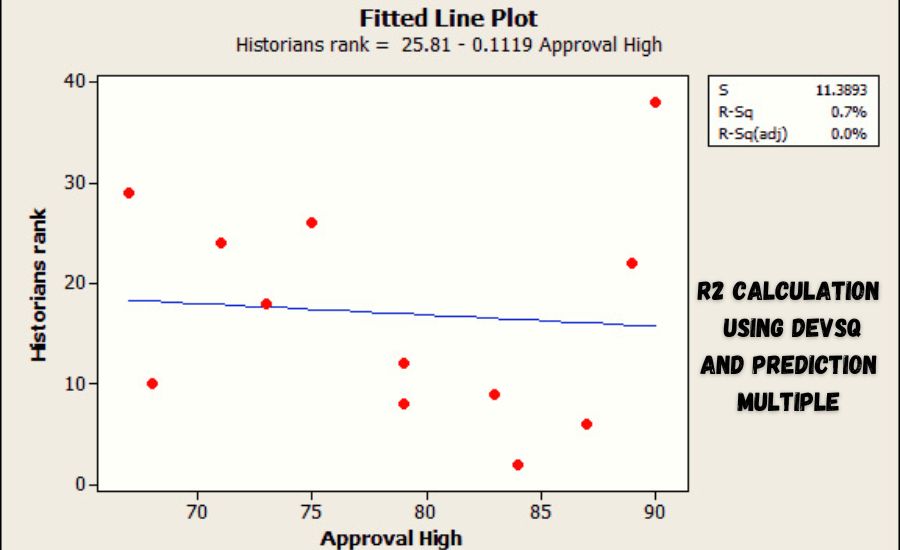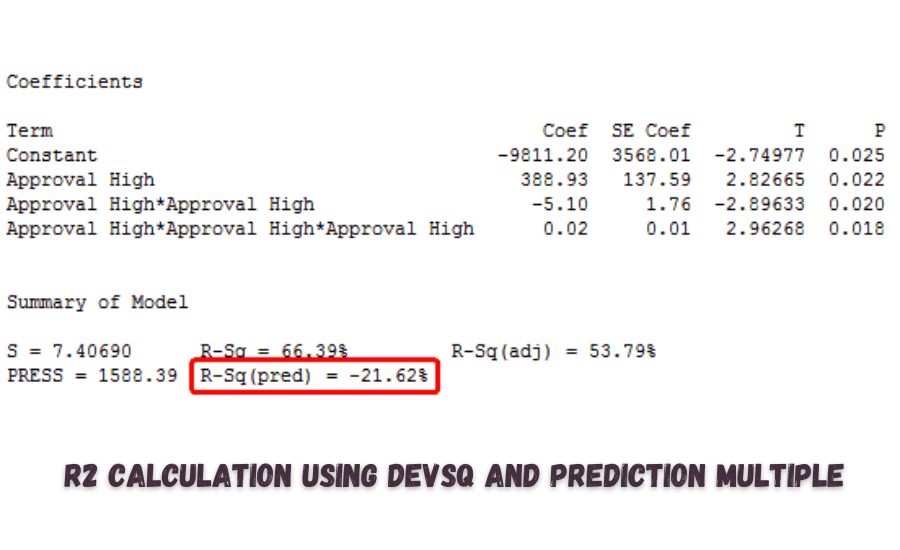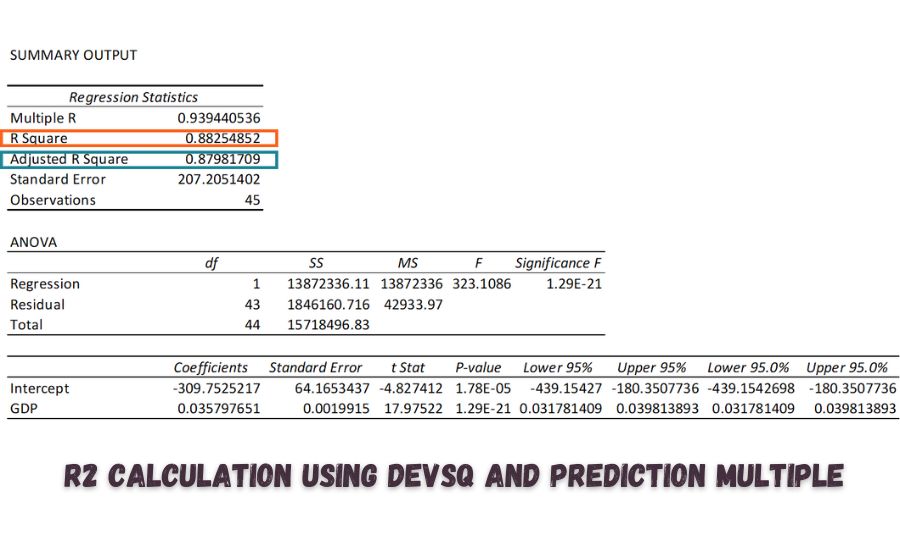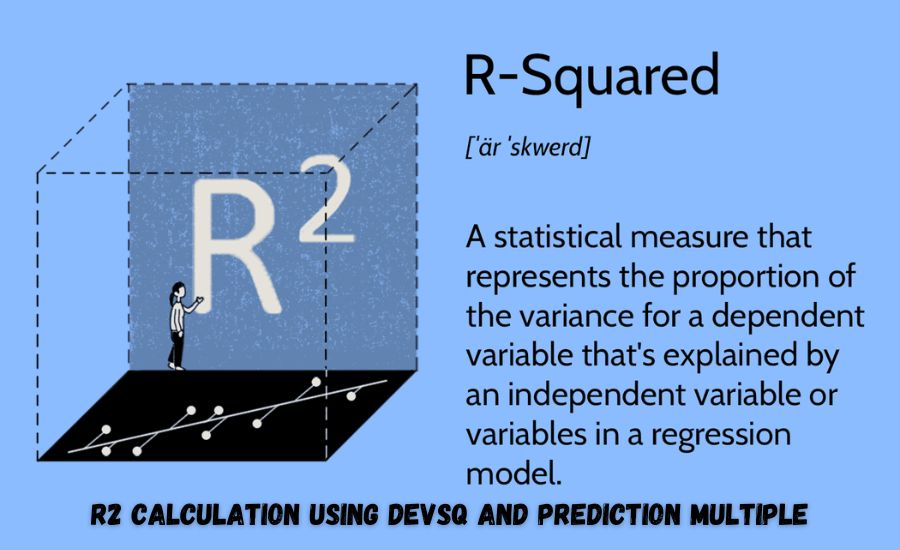R2 calculation using DEVSQ and prediction multiple is a powerful way to measure how well our predictions match accurate data. In this accessible guide, we’ll explore these methods, breaking down the steps so anyone can understand them. At VistaGlimpse, we’re all about making complex ideas simple. Let’s dive into the world of R2, DEVSQ, and predictions to see how they work together to make your data more transparent.
Understanding R2 calculation is super essential for making accurate predictions. Whether you’re new to this concept or looking to deepen your understanding, we’ll explain everything in simple terms. By the end, you’ll know how to use DEVSQ and prediction multiple to achieve precise predictions every time!
What Is R2 Calculation Using DEVSQ and Prediction Multiple?
R2 calculation using DEVSQ and prediction multiple is a way to see how well a model’s predictions match actual data. This method helps check if the model can accurately predict results. By using DEVSQ (deviation squared), we measure how far each data point is from the mean. This distance gives us an idea of how close or far the predictions are from reality.
Understanding prediction multiple in R2 is also essential. It allows us to see if adding more data points or factors improves the model’s accuracy. The better these predictions match, the closer the R2 value will be to 1, indicating a strong relationship between the variables.
In simpler terms, R2 calculation using DEVSQ and prediction multiple can tell us if our model is reliable or needs improvement. Knowing this makes creating models that work well with real-world data easier. With this approach, anyone can start checking how good their predictions are step by step.
DEVSQ and prediction multiple make R2 calculations easier to understand and apply, even if you’re starting with data. By learning these basics, you’ll be ready to analyze data meaningfully, building confidence in your predictions.
Why R2 Calculation Matters for Accurate Predictions
R2 calculation using DEVSQ and prediction multiple is essential for anyone wanting to make predictions. This calculation tells us if our model is on the right track or needs improvement. R2, or the coefficient of determination, is like a score that shows how close predictions are to the actual data.
Having a high R2 score means the predictions are accurate. This accuracy helps in making reliable decisions based on data. If the R2 value is low, the model may be less effective, and adjustments might be needed to improve accuracy.
Incorporating DEVSQ in R2 calculations further improves understanding. DEVSQ measures the spread of data points from the mean, helping to fine-tune the model. Prediction multiple also enhances R2, especially when dealing with complex data.
Using R2 calculation with DEVSQ and prediction, multiple provides insights that strengthen predictions. This is valuable for anyone working with data, from beginners to experts, as it guides towards more reliable results.
Breaking Down the DEVSQ Function: How It Works in R2 Calculations
The DEVSQ function in R2 calculation using DEVSQ and prediction multiple is crucial for measuring data accuracy. DEVSQ, or deviation squared, shows how much each data point differs from the average. This measurement tells us if our data is consistent or if significant gaps need attention.
By squaring the differences, DEVSQ gives a clearer picture of the data spread. Squaring eliminates negative values, making all deviations positive, which helps in accurately calculating R2. This step is vital because it shows if the data is close to the predicted line or scattered far apart.
DEVSQ plays a vital role in refining R2 scores. Combined with prediction multiple, it strengthens the model’s accuracy, especially in complex datasets. Prediction multiple allows for more variables, giving a deeper look into how factors interact.
Using DEVSQ in R2 calculations is a powerful tool. It helps keep predictions sharp and reliable, precisely what is needed for data-driven decisions.
Step-by-Step Guide to Using DEVSQ in R2 Calculation

Using DEVSQ in R2 calculation with prediction multiple can feel complex, but a step-by-step approach makes it more accessible. First, gather your data and calculate the mean. This means it serves as the center point for measuring deviations. DEVSQ helps calculate how far each point is from this mean.
After finding the mean, calculate each data point’s deviation from it. Square these differences to eliminate negative values, then sum them up. This sum of squared deviations (DEVSQ) gives a foundation for calculating R2.
With DEVSQ ready, you can move to prediction multiple. Adding more variables in this step helps refine the accuracy of R2. This approach helps ensure your model is as close to data patterns as possible.
This step-by-step method makes R2 calculation using DEVSQ and prediction multiple manageable. Even with little experience, anyone can follow these steps to see how well their predictions align with actual outcomes.
How Prediction Multiple Works in R2 Calculations
Prediction multiple is integral to R2 calculation using DEVSQ and prediction multiple. It allows more factors, or variables, to be Modeled in such a way that it can lead to a more accurate prediction. By considering more data, prediction multiple helps the R2 value reflect a more complete picture.
Adding variables through prediction multiple shows how each factor impacts the outcome. This addition can improve the R2 score, indicating a more robust match between predictions and actual data. However, adding too many variables can make the model complex, so balance is critical.
Prediction multiple makes R2 calculation more adaptable. It adjusts to different data patterns, ensuring predictions stay relevant even when the data changes. This flexibility is valuable for models that need to stay updated with new information.
Using prediction multiples in R2 calculations enhances accuracy and depth. It’s a powerful method for those who want to understand their data more deeply and improve prediction reliability.
R2 Calculation Using DEVSQ: A Beginner’s Guide
R2 calculation using DEVSQ and prediction multiple may sound technical, but it’s easy to understand with a simple guide. First, R2 measures how well a model’s predictions align with accurate data. It’s like a scorecard, with a high R2 value showing a good match.
DEVSQ, or deviation squared, calculates how far data points are from the mean. This step helps reveal if data is tightly grouped or spread out. A smaller DEVSQ value means data is closer to the mean, which improves R2 accuracy.
To calculate R2, we combine DEVSQ with prediction multiple. Prediction multiple allows for more variables, adding depth to the model. When all these parts work together, R2 calculation becomes an effective tool for measuring prediction accuracy.
This beginner’s guide to R2 calculation using DEVSQ and prediction multiple provides a solid start. By understanding these basics, anyone can start evaluating data with confidence.
What Is Prediction Multiple, and How Does It Improve R2?
Prediction r2 calculation using devsq and prediction multiplen more detailed and reliable. It allows the use of more variables so the model can capture more information. This addition can improve R2, showing a closer match between predictions and actual data.
Using prediction multiple in R2 calculations is helpful, especially when dealing with complex data. The model can respond better to changes with more factors, making predictions more accurate. However, balancing the number of variables is essential to avoid making the model too complex.
DEVSQ works alongside prediction multiple to provide a stable foundation for R2 calculation. By measuring data spread and adding factors, prediction multiple makes R2 results more transparent and precise.
Understanding prediction multiple in R2 calculations is critical for those aiming for accurate predictions. It enhances the model’s accuracy, giving you results you can trust.
Practical Examples of R2 Calculation Using DEVSQ and Prediction Multiple
Learning R2 calculation using DEVSQ and prediction multiple is more straightforward with examples. Imagine predicting test scores based on study hours. The more accurate the prediction, the higher the R2 value will be. Here, DEVSQ shows how far each score is from the average score.
By adding prediction multiple, you could include factors like sleep hours or diet, making the model more accurate. This approach shows whether these additional variables improve predictions or make no difference.
Another example could be forecasting sales based on advertising spend. DEVSQ would measure how close the predictions are to actual sales. Adding prediction multiple, like customer age or location, helps refine R2 accuracy.
Using practical examples, the R2 calculation with DEVSQ and prediction multiple is clear. It shows how adding variables can enhance prediction strength, helping you make better data decisions.
Common Mistakes to Avoid in R2 Calculation with DEVSQ

Some mistakes can lead to errors when performing r2 calculation using devsq and prediction multiple using DEVSQ and prediction multiple. A common one is using too many variables in prediction multiple. Adding too many factors can make the model complex without improving R2 accuracy.
Another mistake is ignoring DEVSQ’s role in measuring data spread. DEVSQ shows if data points are close to the mean or scattered. Skipping this step can weaken the R2 calculation, making it less reliable.
Forgetting to check each variable’s importance can also impact R2. Some variables may not improve accuracy and could even lower R2 scores. Being selective with multiple predictions helps keep the model clear and compelling.
Avoiding these mistakes ensures a smooth R2 calculation with DEVSQ and prediction multiple. These steps make predictions more accurate and models more straightforward to understand.
Exploring the Benefits of Using Prediction Multiple for R2 Accuracy
R2 calculation using devsq and prediction multiple have several benefits. Adding extra factors allows the model to capture more detail, increasing R2 accuracy. This leads to predictions that are more in line with accurate data.
Using prediction multiple also makes the model flexible. It can adjust to new data, helping the R2 score remain high even when information changes. This is especially useful in fields where data varies frequently, like sales or weather.
The DEVSQ function adds to these benefits by showing data spread. DEVSQ helps check if data is clustered or spread out, giving the model a solid base. Together, DEVSQ and prediction multiple make R2 calculation a valuable tool.
These benefits make prediction multiple a go-to choice for accurate predictions. It enhances R2, providing results you can rely on for data analysis.
When to Use DEVSQ in Your R2 Calculations for Best Results
Knowing when to use DEVSQ in r2 calculation using devsq and prediction multiple can improve your results. DEVSQ is best for data that needs to be accurate in showing how points vary from the mean. This is helpful when the data has a large spread or when the model is complex.
Using DEVSQ is ideal when you want to measure prediction strength. It helps calculate R2, showing whether your predictions match the data well. Combining DEVSQ with prediction multiple enhances this effect, especially when using multiple variables.
DEVSQ works well in R2 calculations that require detailed analysis. It highlights where data points fall, helping adjust the model as needed. This combination of DEVSQ and prediction multiple makes predictions sharper.
Applying DEVSQ correctly in r2 calculation using devsq and prediction multiple ensures the best results. It improves model accuracy, making prediction reliability easier to interpret.
Top Tips for R2 Calculation Using DEVSQ and Prediction Multiple
A few tips can make the process smoother for accurate R2 calculation using DEVSQ and prediction multiple. First, start with a clear understanding of DEVSQ’s role. DEVSQ measures how far data points are from the mean, providing a base for calculating R2.
Next, be selective with prediction multiple. Adding too many variables can make the model confusing. Choose factors that truly impact the results to keep the R2 score meaningful.
Another tip is to double-check your calculations. Ensure that each step in DEVSQ and prediction multiple is accurate to avoid errors in R2. These small steps make a big difference in the overall outcome.
By following these tips, R2 calculation becomes more accessible and more effective. You’ll achieve better predictions and more robust models for any data set.
Comparing DEVSQ and Prediction Multiple in R2 Calculations
DEVSQ and prediction multiple play vital roles in r2 calculation using devsq and prediction multiple but serve different purposes. DEVSQ measures how far data points are from the mean, showing the spread of data. This helps establish a base for R2 accuracy.
Prediction multiple, however, allows additional variables to be added. This can improve the R2 score by capturing more data details and enhancing prediction strength. Together, DEVSQ and prediction multiple make the R2 calculation thorough and accurate.
While DEVSQ gives a snapshot of data spread, prediction multiple adds depth. Both are necessary for a reliable R2 calculation, especially for complex data. This comparison shows how these methods complement each other.
Understanding DEVSQ and prediction multiple helps in creating strong R2 models. Each has its place, making data predictions more precise and dependable.
How DEVSQ and Prediction Multiple Can Transform Your Data Analysis

Using DEVSQ and prediction r2 calculation using devsq and prediction multiple can completely change how you analyze data. DEVSQ shows how much data points vary from the mean, helping you understand the spread. This measurement is essential for spotting patterns in data and improving accuracy.
Prediction multiple allows more variables to be added to the R2 calculation, making predictions more accurate. By including these extra factors, the model can better reflect real-world data, making your analysis stronger and more reliable.
DEVSQ and prediction multiple give you a clear picture of your data’s accuracy. They work as a team, where DEVSQ shows variation and prediction multiple brings depth. This combination helps in creating models that truly represent the data.
Transforming your data analysis with DEVSQ and prediction multiple can lead to better decisions. These tools make predictions more precise, offering results that you can trust.
R2 Calculation Made Easy: Using DEVSQ and Prediction Multiple Together
R2 calculation using DEVSQ and prediction multiple may seem complex, but it’s simple with a few steps. DEVSQ is the starting point, showing how far data points are from the mean. This initial calculation is essential for a strong R2 score.
Prediction multiple follows, adding extra variables to the mix. The R2 calculation becomes more accurate with more variables and better reflects the data. This approach allows the model to capture details that a single variable might miss.
Together, DEVSQ and prediction multiple create a strong foundation for R2. DEVSQ handles the spread, while prediction multiple fine-tunes the accuracy. This combination makes r2 calculation using devsq and prediction multiple both easy and effective.
Using these tools simplifies data analysis and provides reliable results. Whether you’re new to data or experienced, this method offers a solid approach to R2 calculation.
Using DEVSQ in Complex R2 Calculations for Precise Results
When dealing with complex data, R2 calculation using DEVSQ and prediction multiple can make a difference. DEVSQ is especially helpful in these cases because it shows the spread of data points, even when they vary widely from the mean.
For complex R2 calculations, DEVSQ gives clarity. It shows if data points are close or scattered, guiding adjustments in the model. Prediction multiple adds detail by allowing more variables, improving the R2 calculation for complex data sets.
DEVSQ helps create precise results in detailed analyses. It simplifies the complex process, breaking down data into understandable parts. When combined with prediction multiple, the R2 model is more accurate.
Using DEVSQ in complex r2 calculation using devsq and prediction multiple helps achieve accurate predictions. It transforms data into insights, making your model reliable and ready for use.
Why Prediction Multiple Enhances R2 Calculation Accuracy
Prediction multiple is valuable for improving R2 calculation using DEVSQ and prediction multiple. By adding more variables, prediction multiple enhances prediction accuracy. It helps capture more information about the data, making the R2 score stronger.
Using prediction multiple means that the model is not limited to just one factor. Instead, it can include various influences that better reflect the real-world scenario. This approach makes R2 more reliable, showing whether the model matches actual data.
DEVSQ adds a base for this accuracy by measuring data spread. DEVSQ and prediction multiple create a detailed r2 calculation using devsq and prediction multiple, capturing every aspect of the data. This precision is helpful for anyone who wants accurate results from their data analysis.
Prediction multiple makes R2 calculation robust and adaptable. With this approach, you can trust the model to deliver results close to reality.
How to Improve Prediction Reliability with DEVSQ and Prediction Multiple
Improving prediction reliability with R2 calculation using DEVSQ and prediction multiple is easy with a few steps. DEVSQ first shows how close data points are to the mean, helping to establish a base for reliable predictions.
Adding prediction multiple increases this reliability. More variables mean the model can reflect different factors that affect the data. This way, the R2 score shows if the model is accurate or needs adjustments to make better predictions.
Together, DEVSQ and r2 calculation using devsq and prediction multiple. DEVSQ checks data consistency, while prediction multiple adds flexibility to the model. This combination leads to higher accuracy, making predictions you can trust.
Using both DEVSQ and prediction multiple is the best approach for reliable predictions. It makes your R2 calculations thorough, accurate, and ready for any data challenge.
Conclusion
R2 calculation using DEVSQ and prediction multiple is a simple yet powerful way to check how well a model’s predictions match accurate data. DEVSQ helps by showing how spread out the data is, while prediction multiple lets us add extra factors to improve accuracy. Together, they make predictions more precise and more reliable, which is helpful for anyone who wants to understand data better.
Using these methods makes data analysis more transparent and more precise. By following these steps, you can trust your predictions and know they are based on solid calculations. Whether new to data or experienced, r2 calculation using devsq and prediction multiple with DEVSQ and prediction multiple is a great way to get accurate results every time.
Must-Have Information: Corporate wants you to find the difference template
FAQs
Q: What is R2 calculation using DEVSQ and prediction multiple?
A: R2 calculation using DEVSQ and prediction multiple is a method for measuring how well a model’s predictions match actual data by examining the data spread and adding variables to improve accuracy.
Q: Why is DEVSQ important in R2 calculations?
A: DEVSQ shows how much each data point deviates from the mean, helping to understand data spread, which is crucial for accurate R2 calculations.
Q: How does prediction multiple improve R2 calculations?
A: Prediction multiple adds extra variables to the model, making predictions more accurate by capturing more factors that affect the data.
Q: Can I use the R2 calculation without DEVSQ?
A: DEVSQ adds valuable information about data spread, making the R2 calculation more reliable.
Q: Is prediction multiple always needed in R2 calculations?
A: Not constantly, but adding prediction multiple can improve accuracy by considering numerous variables, which is helpful in complex data sets.
Q: What does a high R2 value mean?
A: A high R2 value means the model’s predictions closely match the data, showing a strong relationship.
Q: How do I calculate R2 using DEVSQ?
A: First, find the mean, calculate each data point’s deviation from it, square these deviations, sum them up, and then integrate prediction multiple if needed.
Q: Why is R2 valuable calculation in data analysis?
A: R2 calculation helps assess prediction accuracy, making it a valuable tool for creating reliable models in data analysis.


